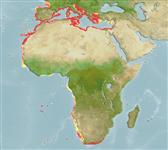>
Eupercaria/misc (Various families in series Eupercaria) >
Sparidae (Porgies)
Etymology: Diplodus: Greek, diploos = twice + Greek, odous = teeth (Ref. 45335).
More on author: Lowe.
Environment: milieu / climate zone / depth range / distribution range
Οικολογία
Θαλασσινό(ά) Υφαλόφιλο(α); ωκεανόδρομο(ς) (Ref. 51243); εύρος βάθους 30 - 300 m (Ref. 3688). Subtropical; 47°N - 35°S, 19°W - 36°E
Eastern Atlantic: Bay of Biscay and the Mediterranean to the Strait of Gibraltar and South Africa including Madeira and the Canary islands, but absent from Cape Verde, off Senegal and the Gulf of Guinea.
Length at first maturity / Μέγεθος / Βάρος / Age
Maturity: Lm 27.3, range 22 - ? cm
Max length : 55.0 cm TL αρσενικό/απροσδιόριστο; (Ref. 2715); common length : 35.0 cm TL αρσενικό/απροσδιόριστο; (Ref. 2715); μεγ. δημοσιευμένο βάρος: 2.7 kg (Ref. 40637)
Benthopelagic on the shelf, on rocky bottoms from 30 to 80 m depth, but may also occur down to 300 m on muddy bottoms. Forms schools of 4 or 5 individuals of different sizes. Omnivorous, feeds on small invertebrates and seaweeds (Ref. 4781).
Life cycle and mating behavior
Maturities | Αναπαραγωγή | Spawnings | Egg(s) | Fecundities | Προνύμφες
Also Ref. 4781.
Bauchot, M.-L. and J.-C. Hureau, 1990. Sparidae. p. 790-812. In J.C. Quero, J.C. Hureau, C. Karrer, A. Post and L. Saldanha (eds.) Check-list of the fishes of the eastern tropical Atlantic (CLOFETA). JNICT, Lisbon; SEI, Paris; and UNESCO, Paris. Vol. 2. (Ref. 3688)
IUCN Red List Status (Ref. 130435)
Threat to humans
Harmless
Human uses
αλιεία: περιορισμένης εμπορικότητας; αλιεία αναψυχής: ναί
Εργαλεία
Special reports
Download XML
Διαδικτυακές πηγές
Estimates based on models
Preferred temperature (Ref.
123201): 13.3 - 17.9, mean 14.9 °C (based on 141 cells).
Phylogenetic diversity index (Ref.
82804): PD
50 = 0.5000 [Uniqueness, from 0.5 = low to 2.0 = high].
Bayesian length-weight: a=0.01122 (0.00718 - 0.01752), b=3.07 (2.94 - 3.20), in cm total length, based on LWR estimates for this species & Genus-body shape (Ref.
93245).
Τροφικό Επίπεδο (Ref.
69278): 3.0 ±0.37 se; based on food items.
Ελαστικότητα (Ref.
120179): Χαμηλό, ελάχιστος χρόνος για διπλασιασμό πληθυσμού 4,5 - 14 έτη (Preliminary K or Fecundity.).
Fishing Vulnerability (Ref.
59153): Moderate to high vulnerability (55 of 100).
Climate Vulnerability (Ref.
125649): Low to moderate vulnerability (26 of 100).
Nutrients (Ref.
124155): Calcium = 25 [11, 41] mg/100g; Iron = 0.555 [0.295, 1.054] mg/100g; Protein = 20.1 [19.0, 21.2] %; Omega3 = 0.226 [0.116, 0.462] g/100g; Selenium = 22.8 [10.8, 41.7] μg/100g; VitaminA = 38.1 [11.0, 125.1] μg/100g; Zinc = 0.786 [0.517, 1.182] mg/100g (wet weight);
